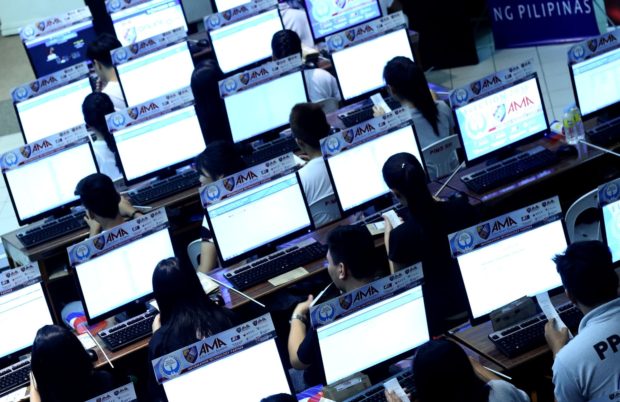PPCRV ends partial, unofficial count

Parish Pastoral Council for Resposinble Voting Volunteers manually audit the receipt of election results at their command center in Pope Pius, Manila. INQUIRER PHOTO / RICHARD A. REYES
After record transmissions in terms of speed and number of precincts, the Parish Pastoral Council for Responsible Voting (PPCRV) on Wednesday ended its partial and unofficial count of the May 9 election results.
The PPCRV, the citizens arm of the Commission on Elections (Comelec) was able to count the votes in 96.14 percent of 94,276 precincts, the highest transmission it has received since the Philippines began holding automated elections in 2010.
The unofficial count of the PPCRV before it shut down its screens publicly showing the results showed Rodrigo Duterte leading the presidential race with 15,970,018 votes, and Leni Robredo on top in the vice presidential race with 14,023,093 votes.
In the senatorial race, Franklin Drilon was No. 1 with 18,153,384 votes.
The PPCRV count is based on results transmitted by the vote-counting machines to the Comelec transparency server.
After the quick count, the PPCRV will focus on its manual audit of the results, which is intended to check for discrepancies.
The PPCRV decided to end its public quick count because the Comelec was already set to officially proclaim the winning senatorial candidates today (Thursday).
Congress is scheduled to convene next week to canvass the votes for President and Vice President, according to the PPCRV’s media and communications director, Ana de Villa Singson.
“We deemed it best to already shut down our screens now to avoid any further confusion because as I always said, ‘this is unofficial,’” Singson told reporters.
But she said the transparency server would continue to receive voting results, if any more come in, and the PPCRV would still be able to access these.
She lauded the Comelec steering committee on Wednesday for the fast transmission of results. “It’s really incredibly fast,” she said. “Let’s give credit where credit is due.”
During the 2010 automated elections, the PPCRV reached just 91.6-percent transmission before it ended its quick count, and during the 2013 midterm polls, it received a “very dismal” 76 percent transmission, she pointed out.
In this year’s elections, the bulk of the results from the precincts came in during the first few hours after the polls shut down at 5 p.m. of May 9. Four hours after the polls closed, the PPCRV already had a 70-percent transmission rate.
In 2010, transmission of results from precincts reached 70 percent after less than nine hours, while in 2013, 70 percent was reached only after 22 hours.
Singson said despite issues that led certain parties to question the credibility of the election results, she believed that the May 2016 polls were well run.
She was referring to the alteration in the script of the Comelec’s transparency server to correct the spelling of a candidate’s name, which some sectors said compromised the voting data, but which poll officials said only resulted in a “cosmetic,” and not substantial, change.
According to her, it saddens her that such an incident occurred considering that results came in so fast.
It’s not just the transmission of election results that had record speed and numbers. The manual audit by the PPCRV is also proceeding at a faster clip this year.
Less than two weeks after the May 9 elections, the PPCRV has encoded the election returns (ERs) of nearly half of the more than 94,000 precincts.
The encoding of the results is one of the more time-consuming steps of the manual audit. The numbers on the ERs are checked against those that appeared on the transparency server to look for discrepancies.


















